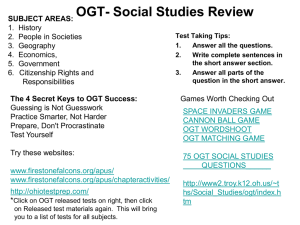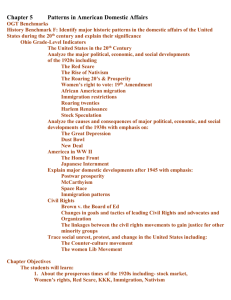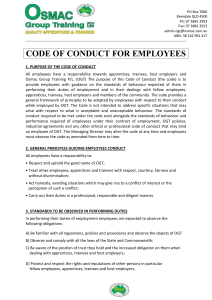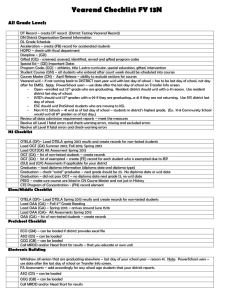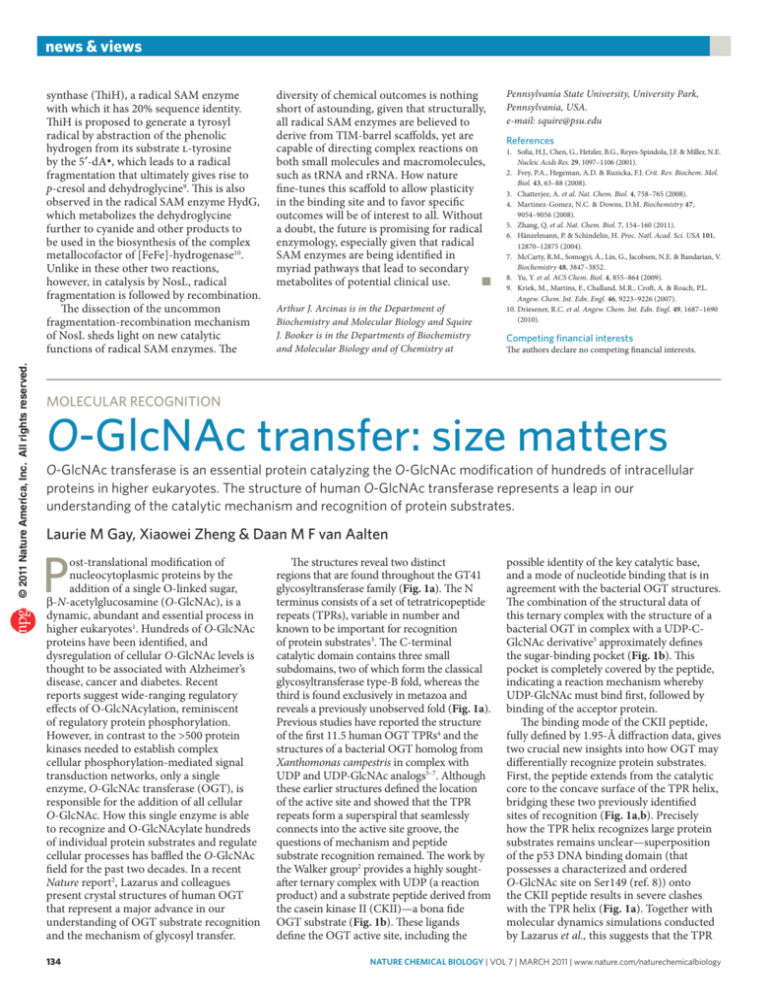
news & views
© 2011 Nature America, Inc. All rights reserved.
synthase (ThiH), a radical SAM enzyme
with which it has 20% sequence identity.
ThiH is proposed to generate a tyrosyl
radical by abstraction of the phenolic
hydrogen from its substrate l-tyrosine
by the 5′-dA•, which leads to a radical
fragmentation that ultimately gives rise to
p-cresol and dehydroglycine9. This is also
observed in the radical SAM enzyme HydG,
which metabolizes the dehydroglycine
further to cyanide and other products to
be used in the biosynthesis of the complex
metallocofactor of [FeFe]-hydrogenase10.
Unlike in these other two reactions,
however, in catalysis by NosL, radical
fragmentation is followed by recombination.
The dissection of the uncommon
fragmentation-recombination mechanism
of NosL sheds light on new catalytic
functions of radical SAM enzymes. The
diversity of chemical outcomes is nothing
short of astounding, given that structurally,
all radical SAM enzymes are believed to
derive from TIM-barrel scaffolds, yet are
capable of directing complex reactions on
both small molecules and macromolecules,
such as tRNA and rRNA. How nature
fine-tunes this scaffold to allow plasticity
in the binding site and to favor specific
outcomes will be of interest to all. Without
a doubt, the future is promising for radical
enzymology, especially given that radical
SAM enzymes are being identified in
myriad pathways that lead to secondary
metabolites of potential clinical use.
■
Arthur J. Arcinas is in the Department of
Biochemistry and Molecular Biology and Squire
J. Booker is in the Departments of Biochemistry
and Molecular Biology and of Chemistry at Pennsylvania State University, University Park,
Pennsylvania, USA.
e-mail: squire@psu.edu
References
1. Sofia, H.J., Chen, G., Hetzler, B.G., Reyes-Spindola, J.F. & Miller, N.E.
Nucleic Acids Res. 29, 1097–1106 (2001).
2. Frey, P.A., Hegeman, A.D. & Ruzicka, F.J. Crit. Rev. Biochem. Mol.
Biol. 43, 63–88 (2008).
3. Chatterjee, A. et al. Nat. Chem. Biol. 4, 758–765 (2008).
4. Martinez-Gomez, N.C. & Downs, D.M. Biochemistry 47,
9054–9056 (2008).
5. Zhang, Q. et al. Nat. Chem. Biol. 7, 154–160 (2011).
6. Hänzelmann, P. & Schindelin, H. Proc. Natl. Acad. Sci. USA 101,
12870–12875 (2004).
7. McCarty, R.M., Somogyi, Á., Lin, G., Jacobsen, N.E. & Bandarian, V.
Biochemistry 48, 3847–3852.
8. Yu, Y. et al. ACS Chem. Biol. 4, 855–864 (2009).
9. Kriek, M., Martins, F., Challand, M.R., Croft, A. & Roach, P.L.
Angew. Chem. Int. Edn. Engl. 46, 9223–9226 (2007).
10.Driesener, R.C. et al. Angew. Chem. Int. Edn. Engl. 49, 1687–1690
(2010).
Competing financial interests
The authors declare no competing financial interests.
MOLECULAR RECOGNITION
O-GlcNAc transfer: size matters
O-GlcNAc transferase is an essential protein catalyzing the O-GlcNAc modification of hundreds of intracellular
proteins in higher eukaryotes. The structure of human O-GlcNAc transferase represents a leap in our
understanding of the catalytic mechanism and recognition of protein substrates.
Laurie M Gay, Xiaowei Zheng & Daan M F van Aalten
P
ost-translational modification of
nucleocytoplasmic proteins by the
addition of a single O-linked sugar,
β-N-acetylglucosamine (O-GlcNAc), is a
dynamic, abundant and essential process in
higher eukaryotes1. Hundreds of O-GlcNAc
proteins have been identified, and
dysregulation of cellular O-GlcNAc levels is
thought to be associated with Alzheimer’s
disease, cancer and diabetes. Recent
reports suggest wide-ranging regulatory
effects of O-GlcNAcylation, reminiscent
of regulatory protein phosphorylation.
However, in contrast to the >500 protein
kinases needed to establish complex
cellular phosphorylation-mediated signal
transduction networks, only a single
enzyme, O-GlcNAc transferase (OGT), is
responsible for the addition of all cellular
O-GlcNAc. How this single enzyme is able
to recognize and O-GlcNAcylate hundreds
of individual protein substrates and regulate
cellular processes has baffled the O-GlcNAc
field for the past two decades. In a recent
Nature report2, Lazarus and colleagues
present crystal structures of human OGT
that represent a major advance in our
understanding of OGT substrate recognition
and the mechanism of glycosyl transfer.
134
The structures reveal two distinct
regions that are found throughout the GT41
glycosyltransferase family (Fig. 1a). The N
terminus consists of a set of tetratricopeptide
repeats (TPRs), variable in number and
known to be important for recognition
of protein substrates3. The C-terminal
catalytic domain contains three small
subdomains, two of which form the classical
glycosyltransferase type-B fold, whereas the
third is found exclusively in metazoa and
reveals a previously unobserved fold (Fig. 1a).
Previous studies have reported the structure
of the first 11.5 human OGT TPRs4 and the
structures of a bacterial OGT homolog from
Xanthomonas campestris in complex with
UDP and UDP-GlcNAc analogs5–7. Although
these earlier structures defined the location
of the active site and showed that the TPR
repeats form a superspiral that seamlessly
connects into the active site groove, the
questions of mechanism and peptide
substrate recognition remained. The work by
the Walker group2 provides a highly soughtafter ternary complex with UDP (a reaction
product) and a substrate peptide derived from
the casein kinase II (CKII)—a bona fide
OGT substrate (Fig. 1b). These ligands
define the OGT active site, including the
possible identity of the key catalytic base,
and a mode of nucleotide binding that is in
agreement with the bacterial OGT structures.
The combination of the structural data of
this ternary complex with the structure of a
bacterial OGT in complex with a UDP-CGlcNAc derivative5 approximately defines
the sugar-binding pocket (Fig. 1b). This
pocket is completely covered by the peptide,
indicating a reaction mechanism whereby
UDP-GlcNAc must bind first, followed by
binding of the acceptor protein.
The binding mode of the CKII peptide,
fully defined by 1.95-Å diffraction data, gives
two crucial new insights into how OGT may
differentially recognize protein substrates.
First, the peptide extends from the catalytic
core to the concave surface of the TPR helix,
bridging these two previously identified
sites of recognition (Fig. 1a,b). Precisely
how the TPR helix recognizes large protein
substrates remains unclear—superposition
of the p53 DNA binding domain (that
possesses a characterized and ordered
O-GlcNAc site on Ser149 (ref. 8)) onto
the CKII peptide results in severe clashes
with the TPR helix (Fig. 1a). Together with
molecular dynamics simulations conducted
by Lazarus et al., this suggests that the TPR
nature chemical biology | VOL 7 | MARCH 2011 | www.nature.com/naturechemicalbiology
news & views
a
b
TPRs
UdP –4
–3
–2
–1
+2
+1
0
his 498
+3
GlcnAc
+4
CKII peptide
his 558
c
© 2011 Nature America, Inc. All rights reserved.
–4
–2
–1
Asn557
Phe868
Ala896
Pro897
Val895
Asn557
his558
Pro559
his562
UdP
Gln839
Phe868
UdP
100.0
25.3
44.7
29.1
–3
Pocket size
*
0
his498
his558
+1
Lys634
64.4
+2
his496
his498
his499
18.0
+3
his496
Lys634
Ala636
38.5
+4
Lys396
Asp431
103.8
(Å2)
Figure 1 | Insights into the human OGT structure. (a) The structure reported by Lazarus et al.2 (pink and
blue, GT-B fold; green, middle domain; gray, TPRs; yellow, CKII peptide). The OGT substrate p53 (PDB ID:
1TUP) was superposed into the active site by matching the substrate backbones for –2 to +2 subsites and
is shown in cyan. The steric clashes between the OGT TPRs and p53 are highlighted in red.
(b) Structure of the Lazarus et al.2 hOGT ternary complex (protein surface in pink) with CKII peptide
(sticks with yellow carbons) and UDP (sticks with pink carbons). The position of the sugar as obtained
by superposition with the X. campestris OGT UDP-C-GlcNAc complex5 (blue transparent sticks) is also
shown. The –4 to +4 subsites of peptide binding are labeled, and the two candidates for the catalytic
base are labeled in red. (c) Schematic of human OGT substrate peptide subsite pockets. The sequence
preference (recalculated from Lazarus et al. Supplementary Table 4 (ref. 2)) is placed in context of a
schematic of the subsites formed by the human OGT residues listed below the pockets. Using the Lazarus
et al. coordinates, the size of each of the subsites was approximated by the solvent accessibility of a valine
residue (standard rotamer) placed at each of the positions on the CKII peptide—the smallest subsites
(–3, –1 and +2) are highlighted with red boxes.
helix may well be more flexible than can
be gleaned from static crystal structures.
Second, the peptide complex hints at how
OGT might recognize O-GlcNAc sites.
Some of the subsites (in particular –3, –1
and +2, Fig. 1c) are shallow pockets that
can only accommodate small side chains.
All of the side chains lining these pockets
are conserved from Caenorhabditis elegans
to human. The calculated volumes of these
nature chemical biology | VOL 7 | MARCH 2011 | www.nature.com/naturechemicalbiology
pockets correlate well with the degenerate
O-GlcNAc site sequence pattern presented
by Lazarus et al.2 and others9 (Fig. 1c). Thus,
the depth of these pockets may help OGT to
select from many potential acceptor serines
or threonines in the human proteome.
Current attempts to probe the
functional role of O-GlcNAc in vivo rely on
the use of exquisitely potent and selective
inhibitors of O-GlcNAcase, the enzyme
that removes O-GlcNAc10,11. In addition
to the new insights into mechanism and
specificity, the OGT structures reported
by Lazarus et al. will advance the rational
development of potent OGT inhibitors as
invaluable cell biological probes to study
O-GlcNAc. Finally, the Lazarus et al. work
now enables future studies to effectively
target the catalytic mechanism, dissect
the relative contributions of the catalytic
core and TPRs to substrate binding and
define the function of the enigmatic
middle domain.
■
Laurie M. Gay, Xiaowei Zheng and Daan M.F. van
Aalten are in the Division of Cell Signaling and
Immunology College of Life Sciences, University of
Dundee, Dundee, United Kingdom.
e-mail: dmfvanaalten@dundee.ac.uk
References
1. Hart, G.W., Housley, M.P. & Slawson, C. Nature 446, 1017–1022
(2007).
2. Lazarus, M.B., Nam, Y., Jiang, J., Sliz, P. & Walker, S. Nature
published online, doi:10.1038/nature09638 (16 January 2011).
3. Iyer, S.P. & Hart, G.W. J. Biol. Chem. 278, 24608–24616 (2003).
4. Jínek, M. et al. Nat. Struct. Mol. Biol. 11, 1001–1007 (2004).
5. Clarke, A.J. et al. EMBO J. 27, 2780–2788 (2008).
6. Martinez-Fleites, C. et al. Nat. Struct. Mol. Biol. 15, 764–765 (2008).
7. Dorfmueller, H.C. et al. Amino Acids, published online,
doi:10.1007/s00726-010-0688-y (17 July 2010).
8. Yang, W.H. et al. Nat. Cell Biol. 8, 1074–1083 (2006).
9. Chalkley, R.J., Thalhammer, A., Schoepfer, R. & Burlingame, A.L.
Proc. Natl. Acad. Sci. USA 106, 8894–8899 (2009).
10.Dorfmueller, H.C. et al. Chem. Biol. 17, 1250–1255 (2010).
11.Yuzwa, S.A. et al. Nat. Chem. Biol. 4, 483–490 (2008).
Competing financial interests
The authors declare no competing financial interests.
135

